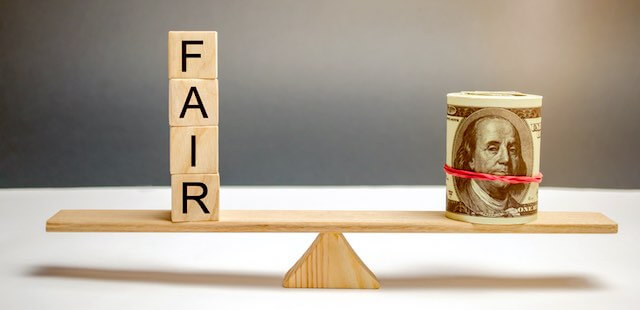The House of Representatives recently passed its version of the fiscal year 2024 National Defense Authorization Act (NDAA). The bill contains a 2024 pay raise for members of the military, and this can be an influential factor in the 2024 federal pay raise.
The House version of the 2024 NDAA authorizes a 5.2% pay raise for military servicemembers. This is the largest military pay raise in over 20 years.
Because the military may get a 5.2% pay raise in 2024, this becomes an argument for pay parity with the military for the annual pay raise for federal employees.
What is Pay Parity?
Pay parity is the idea that federal employees should receive the same annual pay raise as military personnel receive.
There is no requirement that pay parity be implemented in a given year. The argument is frequently raised by federal employee unions when a higher raise for military personnel is proposed. It is also raised by legislators, particularly from the Washington, DC metropolitan area, who are seeking a higher raise for many of their constituents that work for the federal government.
Is It Effective?
While pay parity was an accepted practice for a number of years, the argument has not always been very effective.
Since 2003, there have been 9 years when federal employees have received a smaller pay raise than military personnel. There have not been any years when federal civilians received a higher pay raise than the military.
This table shows how the average military and civilian pay raises have come out over the last 20 years:
| Year | Military Pay Raise | Federal Employee Pay Raise |
|---|---|---|
| 2003 | 4.1% | 4.1% |
| 2004 | 4.2% | 4.1% |
| 2005 | 3.5% | 3.5% |
| 2006 | 3.1% | 3.1% |
| 2007 | 2.7% | 2.2% |
| 2008 | 3.5% | 3.5% |
| 2009 | 3.9% | 3.9% |
| 2010 | 3.4% | 2% |
| 2011 | 1.4% | 0% |
| 2012 | 1.6% | 0% |
| 2013 | 1.7% | 0% |
| 2014 | 1% | 1% |
| 2015 | 1% | 1% |
| 2016 | 1.3% | 1.3% |
| 2017 | 2.1% | 2.1% |
| 2018 | 2.4% | 1.9% |
| 2019 | 2.6% | 1.9% |
| 2020 | 3.1% | 3.1% |
| 2021 | 3.0% | 1% |
| 2022 | 2.7% | 2.7% |
| 2023 | 4.6% | 4.6% |
White House Wants a 5.2% 2024 Federal Pay Raise
President Biden proposed a 5.2% raise for federal employees in 2024, so the House has essentially backed this proposal by pushing the same raise for the military.
The 5.2% figure put forth in the 2024 White House budget proposal is an average raise, meaning that if that is the final figure to be enacted, some federal employees would get more than this and some would get less.
The federal pay raise typically includes one amount for an across-the-board pay raise and another amount allocated toward locality pay. Because locality pay rates vary by region, the final amount of the pay raise is different when locality pay is applied. In 2023 for instance, the pay raise was a base pay increase of 4.1% and an average increase to locality pay 0f 0.5%. This resulted in an overall average 2023 federal pay raise of 4.6%.
A Push for Higher 2024 Federal Pay Raise
Although a 5.2% pay raise for federal employees would be the highest raise for the federal workforce in over 40 years (specifically, since 1980), some Democrats in Congress want more.
Earlier this year, Congressman Gerry Connolly (D-VA) and Senator Brian Schatz (D-HI) introduced their annual legislation to give federal employees an 8.7% pay raise in 2024. This is the same amount as the 2023 annual cost of living adjustment (COLA) for federal retirees.
While it may sound good, the bill has never become law and the federal pay raise has wound up being lower as it meanders through the usual political process each year, but it does serve to kick off the annual political process for setting the pay raise for federal employees.
How is the Annual Federal Pay Raise Determined?
The annual pay raise for federal employees is determined by a political process. This means that the amount of the pay raise, if there is one, will vary from year to year depending on the political climate. This is what makes the process so complex.
In some years, Congress will pass annual federal pay rate adjustments in an appropriations bill. When this occurs, it is usually done in the Financial Services and General Government appropriations bill.
While this often happens, there is no legal requirement that a federal employee pay raise be addressed or considered by Congress. Congress usually does not pass legislation on the subject.
The president can, and often does, recommend a pay raise figure per the alternative pay plan. This is typically done late in the year, usually in August.
Of course, if Congress does not like the amount of the raise in the alternative pay plan, it can still pass new legislation determining the final amount. This is most likely to happen during an election year. With an election coming up, the thought process is likely to be that giving a raise = (hopefully) getting more votes for a candidate running for Congress.
After this political process has played out fully, the president issues an executive order in December setting the amount of the annual federal pay raise by locality for the next year. The Office of Personnel Management (OPM) calculates the amount of the annual salary for every locality, grade, and step for the next year and publishes the pay tables shortly after the executive order is issued.






